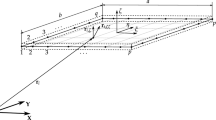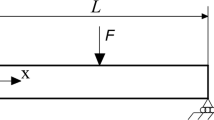Abstract
The computational efficiency has been largely hindering the application of the absolute nodal coordinate formulation (ANCF). To improve the computational efficiency of the absolute nodal coordinate formulation, the collocation strategy is employed to establish the ANCF beam element. A novel ANCF beam element based on multi-node collocation (ANCF_C) is proposed. Zero points of the second-order derivative of pth-order Legendre polynomial and the boundary points in the element domain are used as nodes to discretize the beam node-wisely. Accordingly, the \((p-1)\)th-order Lagrange interpolation is employed for the longitudinal displacement interpolation. The elastic force and stiffness matrix are deduced based on the enhanced continuum mechanics formulation (ECMF) to avoid the locking problem. By using p-point Lobatto quadrature for the numerical integration of the elastic force and the mass matrix, the quadrature points coincide with the discretized nodes in the element. The performance of the ANCF_C is verified by both static and dynamic examples.












Similar content being viewed by others
Data availability
The manuscript has no associated data.
References
Auricchio, F., Beirao, D., Hughes, T.J., Reali, A., Sangalli, G.: Isogeometric collocation for elastostatics and explicit dynamics. Comput. Methods Appl. Mech. Eng. 249–252(1), 2–14 (2012)
Boor de, C.: A practical guide to splines. Springer-Verlag, New York (1978)
Cui, Y., Lan, P., Zhou, H., Yu, Z.: The rigid-flexible-thermal coupled analysis for spacecraft carrying large aperture paraboloid antenna. J. Comput. Nonlinear Dyn. 15(3), 031003 (2020)
Du, X., Du, J., Bao, H., Sun, G.: Deployment analysis of deployable antennas considering cable net and truss flexibility. Aerosp. Sci. Technol. 82, 557–565 (2018)
Ebel, H., Matikainen, M.K., Hurskainen, V.V., Mikkola, A.: Higher-order beam elements based on the absolute nodal coordinate formulation for three-dimensional elasticity. Nonlinear Dyn. 88(2), 1075–1091 (2017)
Gerstmayr, J., Matikainen, M.K., Mikkola, A.M.: A geometrically exact beam element based on the absolute nodal coordinate formulation. Multibody Syst. Dyn. 20(4), 359–384 (2008)
Gerstmayr, J., Sugiyama, H., Mikkola, A.: Review on the absolute nodal coordinate formulation for large deformation analysis of multibody systems. J. Comput. Nonlinear Dyn. 8(3), 031016 (2013)
Géradin, M., Cardona, A.: Flexible multibody dynamics a finite element approach (2001)
Lan, P., Li, K., Yu, Z.: Computer implementation of piecewise cable element based on the absolute nodal coordinate formulation and its application in wire modeling. Acta Mech. 230(3), 1145–1158 (2019)
Li, P., Liu, C., Tian, Q., Hu, H., Song, Y.: Dynamics of a deployable mesh reflector of satellite antenna: form-finding and modal analysis. J. Comput. Nonlinear Dyn. 11(4), 041017 (2016)
Liu, C., Tian, Q., Hu, H.: New spatial curved beam and cylindrical shell elements of gradient-deficient absolute nodal coordinate formulation. Nonlinear Dyn. 70(3), 1903–1918 (2012)
Marino, E.: Isogeometric collocation for three-dimensional geometrically exact shear-deformable beams. Comput. Methods Appl. Mech. Eng. 307, 383–410 (2016)
Nachbagauer, K.: State of the art of ANCF elements regarding geometric description, interpolation strategies, definition of elastic forces, validation and the locking phenomenon in comparison with proposed beam finite elements. Arch. Comput. Methods Eng. 21(3), 293–319 (2014)
Nachbagauer, K., Pechstein, A.S., Irschik, H., Gerstmayr, J.: A new locking-free formulation for planar, shear deformable, linear and quadratic beam finite elements based on the absolute nodal coordinate formulation. Multibody Syst. Dyn. 26(3), 245–263 (2011)
Otsuka, K., Makihara, K., Sugiyama, H.: Recent advances in the absolute nodal coordinate formulation: literature review from 2012 to 2020. J. Comput. Nonlinear Dyn. 17(8), 080803 (2022)
Patel, M., Orzechowski, G., Tian, Q., Shabana, A.A.: A new multibody system approach for tire modeling using ancf finite elements. Proc. Inst. Mech. Eng. Part K: J. Multi-body Dyn. 230(1), 63–84 (2015)
Patel, M., Shabana, A.A.: Locking alleviation in the large displacement analysis of beam elements: the strain split method. Acta Mech. 229(7), 2923–2946 (2018)
Shabana, A.A.: Definition of the slopes and the finite element absolute nodal coordinate formulation. Multibody Syst. Dyn. 1(3), 339–348 (1997)
Shen, Z., Tian, Q., Liu, X., Hu, G.: Thermally induced vibrations of flexible beams using absolute nodal coordinate formulation. Aerosp. Sci. Technol. 29(1), 386–393 (2013)
Simo, J.C., Tarnow, N., Doblare, M.: Non-linear dynamics of three-dimensional rods: exact energy and momentum conserving algorithms. Int. J. Numer. Methods Eng. 38(9), 1431–1473 (1995)
Simo, J.C., Vu-Quoc, L.: A three-dimensional finite-strain rod model. Part II: computational aspects. Comput. Methods Appl. Mech. Eng. 58, 79–116 (1986)
Simo, J.C., Vu-Quoc, L.: On the dynamics in space of rods undergoing large motions : a geometrically exact approach. Comput. Methods Appl. Mech. Eng. 66(2), 125–161 (1987)
Tang, Lei, Baeder, J.D.: Uniformly accurate finite difference schemes for p-refinement. SIAM J. Sci. Comput. 20(3), 1115–1131 (1998)
Tang, Y., Hu, H., Tian, Q.: Model order reduction based on successively local linearizations for flexible multibody dynamics. Int. J. Numer. Methods Eng. 118(3), 159–180 (2018)
Tang, Y., Hu, H., Tian, Q.: A condensed algorithm for adaptive component mode synthesis of viscoelastic flexible multibody dynamics. Int. J. Numer. Methods Eng. 122(2), 609–637 (2020)
Veiga, L., Buffa, A., Rivas, J., Sangalli, G.: Some estimates for h-p-k-refinement in isogeometric analysis. Numer. Math. 118(2), 271–305 (2011)
Yakoub, R.Y., Shabana, A.A.: Three dimensional absolute nodal coordinate formulation for beam elements: implementation and applications. J. Mech. Des. 123(4), 614–621 (2000)
Zupan, D., Saje, M.: Finite-element formulation of geometrically exact three-dimensional beam theories based on interpolation of strain measures. Comput. Methods Appl. Mech. Eng. 192(49/50), 5209–5248 (2003)
Funding
This research was supported by the National Science and Technology Major Project (2019-VII-0004-0144).
Author information
Authors and Affiliations
Corresponding author
Ethics declarations
Conflict of interest
The author(s) declared no potential conflicts of interest with respect to the research, authorship, and/or publication of this article.
Additional information
Publisher's Note
Springer Nature remains neutral with regard to jurisdictional claims in published maps and institutional affiliations.
Rights and permissions
Springer Nature or its licensor (e.g. a society or other partner) holds exclusive rights to this article under a publishing agreement with the author(s) or other rightsholder(s); author self-archiving of the accepted manuscript version of this article is solely governed by the terms of such publishing agreement and applicable law.
About this article
Cite this article
Wang, J., Wang, T., Bian, H. et al. A novel collocation beam element based on absolute nodal coordinate formulation. Acta Mech 234, 2695–2707 (2023). https://doi.org/10.1007/s00707-023-03509-2
Received:
Revised:
Accepted:
Published:
Issue Date:
DOI: https://doi.org/10.1007/s00707-023-03509-2




